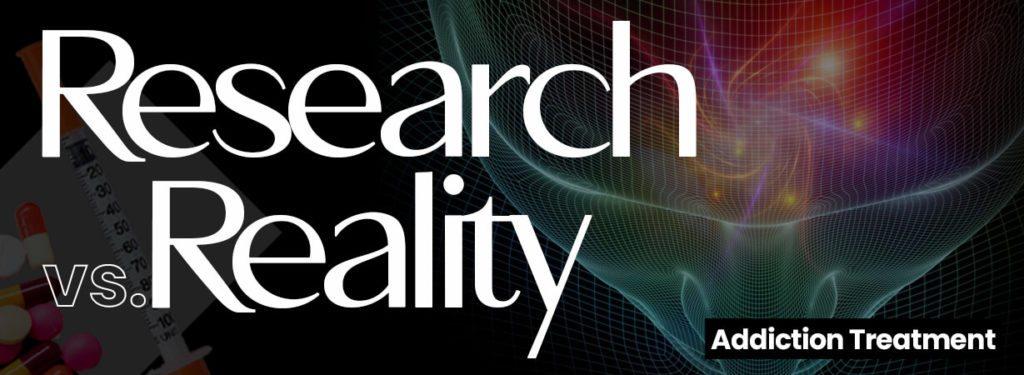Addiction Research vs. Reality
Addiction Treatment backed by Addiction Research
There are thousands of drug and alcohol addiction counselors, treatment centers, and self-help groups around the country. Each one of them with their own unique treatment approach to recovery.
Despite options available, there is a concerning gap, between what research indicates is effective and how addiction treatment is implemented.
Multiple studies have revealed discrepancies between evidence-based practices and the protocols used by many treatment professionals. Therefore, gaps remain in the delivery of care for those struggling with addiction.
Here are some examples of these disparities to help individuals seeking addiction treatment advocate for evidence-based care.

Using Medication to Treat Addiction
According to research by the American Psychiatric Association, pharmacological interventions, such as methadone or naltrexone, are effective in reducing the cravings and negative consequences of alcohol and opiate abuse.
In practice, medications are not used during treatment for a variety of reasons. It might include cost or a lack of understanding of medical maintenance. Often medical practitioners are not available on staff to prescribe medication or negative attitudes about using medication to treat addiction.
While medication can be an effective tool in addiction treatment, it is not always utilized in practice. There are several reasons for this, including cost, lack of medical knowledge, and unavailability of medical practitioners on staff. Additionally, some individuals may have negative attitudes towards using medication as a treatment for addiction.
Contrary to the practicing beliefs of some doctors and treatment facilities, most major medical associations and organizations now highly recommend the use of medication-assisted treatment for many types of addiction, especially heroin addiction, for combatting the heroin epidemic.
How Long Does Treatment Take?
Research by Finney & Moos from 2002 shows that addiction treatment often won’t show successful results until 90 days into treatment. Yet most residential treatment programs are 21 days or less.
Another Addiction Treatment Outcome Study shows that as the length of treatment is increased for more than 30 days, the success rates of treatment increase as well.
Part of the reason for the shortened duration of treatment is the cost, and many facilities treat addiction as an acute, rather than chronic condition.
Further research (McLellan et al., 2000) states that addiction is a chronic, relapsing disorder similar to diabetes. While it cannot be cured, addiction can be managed effectively with long-term support.
Sometimes long-term support can be a combination of inpatient and outpatient treatment in the form of an IOP Program.
Group and Individual Therapy Combined
The National Institute on Drug Abuse (NIDA) research in 1999 shows that the best outcomes come from group therapy that works in conjunction with individual therapy.
On the contrary, many treatment centers and counselors only focus on group therapy because of the cost and a lack of staff that is trained in using individual treatment protocols.
A biopsychosocial model for addiction has shown to be effective because it treats the whole person and examines biological factors like genetic inheritance and factors during birth, as well as psychosocial factors such as family, community, and peers.
Yet, most treatment regimes focus only on substance abuse because of cost and lack of sufficient training and knowledge by counselors and therapists.
Substance Addiction is Not a Choice
For a long time, conventional thought concluded that individuals suffering from substance abuse were immoral or lazy, and chose to be that way. This began to change around the 1950s and 1960s when medical organizations and physicians gained a better understanding of the human brain and behavior. With regard to science, the road to an agreement takes a lot of work and research before forming a consensus.
It wasn’t until 1990 that the American Medical Association approved the ADM code recognizing addiction medicine as a specialty.
Today, almost all major health and medical associations recognize addiction as a disease. With that designation comes a wealth of evidence-based research into the best practices for successful outcomes in treating addiction.
It will take even longer before more doctors, counselors, and treatment facilities begin utilizing the research to provide optimal care for their addicted patients. For now, only a small portion, maybe 10%, use research-based treatment protocols for addiction.
While cost and lack of properly trained and credentialed medical doctors are two of the biggest reasons most treatment facilities don’t use research-based methods for treating addiction, lack of education and understanding play essential roles. It is slowly changing, but that, too, will take time.
For now, individuals must seek treatment that relies on research that shows success in best managing addiction.